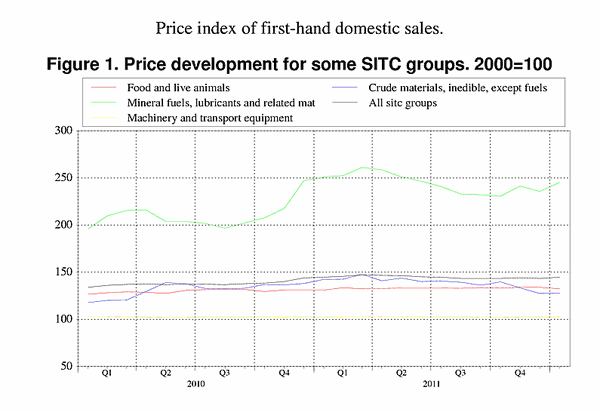Content
Published:
This is an archived release.
Higher prices in energy products
The Price index of first-hand domestic sales (PIF) increased by 0.9 per cent from December 2011 to January 2012. The main reasons were higher prices in electricity, petroleum and petroleum products.
Higher prices in electricity, petroleum and petroleum products, which increased by 4.6 and 4.7 per cent respectively, were the main reasons behind a 4.1 per cent rise within mineral fuels, lubricants and related materials. The growth in electricity prices was mainly caused by colder weather in January.
Price increase in manufactured goods and chemicals
Manufactured goods and chemicals rose by 1.1 and 1.5 per cent respectively from December to January. With a rise of 8 per cent, the price increase in non-ferrous metals was the most important for the price rise in manufactured goods. Higher prices within chemicals were mainly caused by increasing prices in organic and inorganic chemicals.
Decrease in prices of food products
Nearly all groups of food experienced a rise in prices from December to January, except fish, whose prices dropped 8 per cent. Food and live animals fell 1.1 per cent from December to January and helped curb the rise in the overall index.
Twelve month change: small decrease
The strongest contributions behind the 0.1 per cent decrease in PIF over the last twelve months came from crude materials, inedible, except fuels, with a drop of 10.5 per cent. Metalliferous ores and metal scrap had the most influence. Lower prices in electricity of 37.6 per cent were also of great importance.
Chemicals, food and miscellaneous manufactured articles were among the product groups in which prices increased during this twelve month period.
| January 2012 | Changes, per cent | ||||||||||||||||||||||||||||||||||||||||||||||||||||||||||||||||||||||||||||||
|---|---|---|---|---|---|---|---|---|---|---|---|---|---|---|---|---|---|---|---|---|---|---|---|---|---|---|---|---|---|---|---|---|---|---|---|---|---|---|---|---|---|---|---|---|---|---|---|---|---|---|---|---|---|---|---|---|---|---|---|---|---|---|---|---|---|---|---|---|---|---|---|---|---|---|---|---|---|---|---|
|
December 2011-
January 2012 |
January 2011-
January 2012 |
||||||||||||||||||||||||||||||||||||||||||||||||||||||||||||||||||||||||||||||
| Total index | 144.6 | 0.9 | -0.1 | ||||||||||||||||||||||||||||||||||||||||||||||||||||||||||||||||||||||||||||
| Food and live animals | 132.4 | -1.1 | 1.0 | ||||||||||||||||||||||||||||||||||||||||||||||||||||||||||||||||||||||||||||
| Beverages and tobacco | 138.5 | -0.3 | 3.0 | ||||||||||||||||||||||||||||||||||||||||||||||||||||||||||||||||||||||||||||
| Crude materials, inedible, except fuels | 127.6 | 0.1 | -10.5 | ||||||||||||||||||||||||||||||||||||||||||||||||||||||||||||||||||||||||||||
| Mineral fuels, lubricants and related materials | 245.4 | 4.1 | -2.2 | ||||||||||||||||||||||||||||||||||||||||||||||||||||||||||||||||||||||||||||
| Chemicals and related products, n.e.s | 139.9 | 1.5 | 5.6 | ||||||||||||||||||||||||||||||||||||||||||||||||||||||||||||||||||||||||||||
| Manufactured goods classified by material | 132.2 | 1.1 | 0.8 | ||||||||||||||||||||||||||||||||||||||||||||||||||||||||||||||||||||||||||||
| Machinery and transport equipment | 102.7 | 0.3 | 0.5 | ||||||||||||||||||||||||||||||||||||||||||||||||||||||||||||||||||||||||||||
| Miscellaneous manufactured articles | 111.2 | -0.2 | 1.8 | ||||||||||||||||||||||||||||||||||||||||||||||||||||||||||||||||||||||||||||
Updated weightsEntering a new year, the weights used for calculating the price index have been updated. The weights express the influence of different goods on the total price index, and are based on the shares of different goods in the total value of turnover in the Norwegian economy in the previous year. Compared with 2011, the weights of food and live animals and miscellaneous manufactured articles are lower in 2012, while the weights of mineral fuels, lubricants and related materials and machinery and transport equipment increased. All changes in weights are due to changes in both volumes and prices to different degrees. This year, however, there is an additional possible source of shifts in weights. The weights are calculated using data from national accounts. For the first time, these data are grouped according to a new standard. Thus, some changes in weights may occur due to changes in the way certain goods are classified in the old and the new standard. For more on weights, see the table of weights and data in StatBank . |
Additional information
Contact
-
Producer price index
E-mail: produsentpris@ssb.no
tel.: (+47) 21 09 40 00
-
Elisabeth Mælum
E-mail: elisabeth.maelum@ssb.no
tel.: (+47) 97 01 28 49
-
Monika Græsli Engebretsen
E-mail: monika.graesli.engebretsen@ssb.no
tel.: (+47) 40 90 23 71
-
Morten Madshus
E-mail: morten.madshus@ssb.no
tel.: (+47) 40 90 26 94

